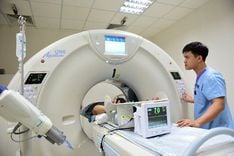This is an automatically translated article.
Bone marrow cancer is a rare disease among all types of cancer. Bone cancer often progresses slowly, so patients often come to the doctor at a late stage.
1. What is bone cancer?
Bone cancer Tumors form in the bones, often starting in long bones in the body such as those in the arms or legs. Bone cancer develops that destroys normal bone cells and spreads to other parts of the body. Bone cancer is often seen in children and young adults.
2. Types of bone cancer
Osteosarcoma occurs in people aged 10 to 30 years, first appearing in the arms, legs or pelvis. Ewing sarcoma occurs in children and young adults, starting in the arms, chest, legs, pelvis, and spine. People over 40 are more likely to get chondrosarcoma, which occurs in the hands, feet, or pelvis. Cancers such as leukemia that start in the bone marrow are not considered bone cancers.
Bệnh ung thư xương có thể xảy ra ở một số vị trí xương khác nhau
3. Rare types of bone cancer
Rare bone cancers commonly seen in adults include giant cell tumors - which often occur around the knee in young people - and choriomas, which usually start at the base of the skull or tailbone. Fibrosarcoma is sometimes seen in older adults after radiation therapy for other cancers, most often in the knees, hips, and jaw.
4. Factors that increase the risk of bone cancer?
Chances of bone marrow cancer are higher if you have a bone disorder called Paget's disease. Treatment of other cancers with high doses of radiation therapy and certain drugs also increases the risk of bone cancer. Occurs more often in children and young adults whose bones are still growing. But with chondrosarcoma, the opposite, the risk increases with age.
5. Health status
Your risk of bone cancer is higher if you have a genetic problem. Genetic problems cause hereditary retinoblastoma, Li-Fraumeni syndrome, and Rothmund-Thomson syndrome. Babies born with an umbilical hernia are more likely to have Ewing's sarcoma.
6. Symptoms of pain
Pain is the most common initial sign. Pain may start slowly or be intense. In addition to bone cancer, pain can be caused by arthritis. See a specialist to find out the cause of the pain.

Khi xuất hiện đau nên đến gặp bác sĩ để được tìm nguyên nhân gây bệnh ung thư xương
7. Other symptoms:
Some other symptoms include:
Fractures (tumors can make bones weaker and easier to break) A tumor on the bone Night sweats Swelling and redness on the bones Fatigue Unexplained weight loss
8. Diagnostic Imaging
Your doctor may recommend X-rays to evaluate and examine your bones, including:
Bone scan: The doctor places a small amount of radioactive material into a vein in your arm, then uses a camera specifically for bone imaging. Computed tomography (CT): X-rays taken from different angles are stitched together to show the size and shape of the tumor and how it has spread. Magnetic Resonance Imaging (MRI): Strong magnets and radio waves are used to show tumor limits. Positron emission tomography (PET): Creates an image with 3D color images to check for cancer in the body.

Một số xét nghiệm hình ảnh giúp bác sĩ đánh giá tình trạng bệnh ung thư xương
9. Biopsy
Your doctor will remove a small part of the tumor - with surgery or with a needle - to identify bone cancer. A biopsy is the only way to know for sure if you have bone cancer.
10. Stage
Imaging tests help the doctor determine the stage of the cancer to make a treatment plan:
Stage I: has not spread beyond the bone and the cancer cells have not grown too quickly.
Stage II: has not spread, but the cancer cells are growing rapidly.
Stage III: in at least two locations on the same bone.
Stage IV: has spread beyond the bone.
11. Surgery
Surgery is indicated based on tumor size, stage and type, and general health. Surgery to remove the tumor is the most common first step. To replace any bone that must be removed with the tumor, the doctor may use bone from another part of the body or from a bone bank, or metal implant.
12. Treatment: Chemotherapy and radiation therapy
A combination of powerful drugs (chemotherapy) and high-energy X-rays (radiotherapy) is sometimes used along with surgery. Chemotherapy and radiation help shrink the previous tumor or kill any cancer cells that may be left behind. Chemotherapy drugs travel throughout the body, so your doctor may also recommend them if the cancer has spread beyond the bones. Doctors recommend radiation therapy if surgery is not possible or helps relieve pain in advanced cancer.
13. Cryosurgery
In this type of surgery, the doctor places a probe filled with liquid nitrogen right next to the tumor. The probe creates an ice ball that freezes and kills the cancer cells. This medicine is often used to treat bone cancer that is not growing rapidly.
14. Post-operative care
Bone cancer can spread to other parts of your body, including other bones, or return to its original location. So you'll have regular follow-up visits with your doctor for blood tests and X-rays. Depending on the treatment and the location of the cancer, you may also need physical therapy to make parts of your body stronger and functional.
Please dial HOTLINE for more information or register for an appointment HERE. Download MyVinmec app to make appointments faster and to manage your bookings easily.
Reference source: webmd.com












